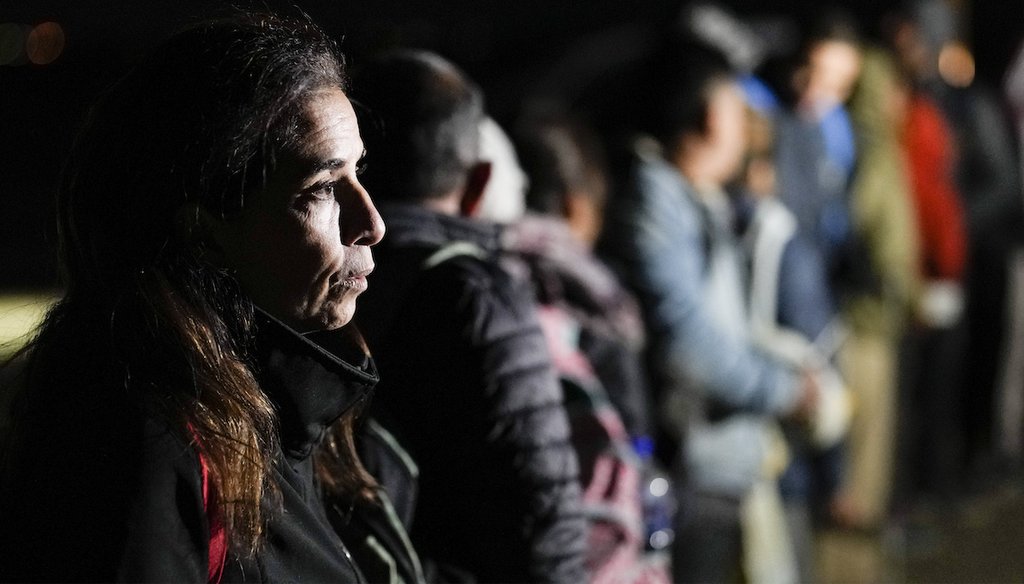Stand up for the facts!
Our only agenda is to publish the truth so you can be an informed participant in democracy.
We need your help.
I would like to contribute

A woman from Cuba waits with other migrants to meet with immigration officials to seek asylum after crossing the border into the United States, Jan. 6, 2023, near Yuma, Ariz. (AP)
If Your Time is short
-
Under Biden’s proposed rule, people who entered the southern U.S. border between ports of entry without first applying for protections in another country are presumed ineligible for asylum.
-
Democrats in Congress and immigration activists have compared the rule with Trump-era policies.
-
Biden’s policy has exceptions and is not a complete asylum ban, but experts say it has clear similarities to Trump’s rules.
President Joe Biden’s administration recently proposed a new rule that would limit an immigrant’s ability to seek asylum at the southern U.S. border. This comes as Biden deals with historic numbers of immigrants reaching the border, including about 1.7 million who entered the U.S. to seek asylum.
Immigration rights advocates and congressional Democrats have criticized Biden’s rule, likening it to restrictive Trump-era policies. Four Democratic senators condemned Biden’s proposal, saying asylum seekers are pursuing a legal path and the U.S. government "should not leave vulnerable migrants stranded in countries unable to protect them."
Under the Biden rule, immigrants who try to enter the U.S. between ports of entry without first seeking asylum or other immigration protections in another country are presumed ineligible for asylum in the U.S., barring some exceptions.
During a press briefing Feb. 23, White House Press Secretary Karine Jean-Pierre said "there is a huge difference" between Biden’s proposed policy and Trump-era restrictions.
"What we are providing is expanded legal pathways," Jean-Pierre said. "That is something that the past administration didn’t do, and that is something that we are doing here."
Here’s what the Biden administration is proposing and how it compares with Trump’s asylum policies. The White House did not respond to our request for comment.
Biden’s policy limits asylum requests
Under the new policy, immigrants seeking asylum must use a phone app to schedule an appointment at a port of entry. If they show up without an appointment or cross into the U.S. between ports of entry, immigrants must prove that they applied for protections in the countries they traveled through to reach the U.S. — and that they were denied.
If they don’t prove this, immigration officials can deem them ineligible for asylum.
Usually, immigrants seeking asylum are interviewed by asylum officers who determine whether those immigrants have a "credible fear" of being persecuted in their home countries.
Under the new rule, immigrants presumed ineligible for asylum must meet a higher bar: They must prove they have a "reasonable fear" of being persecuted in their home country.
"It makes it more difficult," said Rick Su, a University of North Carolina School of Law professor. "It raises the bar by which you would argue for asylum, but it is still theoretically possible" to meet it.
Unaccompanied children, immigrants with an "acute medical emergency," and immigrants who face an "imminent and extreme threat to life or safety," such as threat of rape, kidnapping, torture, or murder, are exempt from meeting the reasonable fear criteria.
The asylum rule, proposed by the departments of Homeland Security and Justice, is set to take effect May 11. That’s when Title 42, a public health policy that has been used to quickly return immigrants at the border back to Mexico, is set to end.
How Biden and Trump's policies are different
Trump proposed rules in 2018 and 2019 to limit who could apply for asylum, but those rules never went into effect because courts blocked them.
One of those rules said people couldn't apply for asylum if they entered the U.S. between ports of entry. The other rule blocked people's ability to apply for asylum if they traveled through another country and did not apply for protections there, even if they arrived at U.S. ports of entry.
Biden’s policy does not outright ban people from seeking asylum, but makes it harder.
This makes Biden’s rule "less absolute and less harsh," said Amanda Frost, a University of Virginia immigration law professor.
"There are some differences that make the Biden proposed rule more lenient and have a little more flexibility to it," Frost said. "But I consider that a difference in degree, not in kind."
Su, at the University of North Carolina, said the differences are not just technical. He said the Biden administration will likely argue that there are also differences in the motivation of its rule and the way it fits into other immigration policies.
The Biden administration is sending a message for asylum seekers to come to the U.S. through pathways other than between ports of entry, Su said.
"They want to say they're just trying to manage the line where they would claim the Trump administration was trying to eliminate the line," Su said.
Asylum rule will disadvantage people desperate for asylum, experts said
Whether asylum will remain accessible to immigrants under the new Biden rule remains to be seen.
Immigrants from Venezuela, Haiti, Nicaragua and Cuba have had access to the asylum phone app since January under a parole program the Biden administration created. But immigrants and activists say the app often stops working, has limited appointment times, and struggles to capture photos of people with darker skin tones.
Frost said people who have access to a smartphone, reliable internet and the time to wait for an appointment are likely not the people who are most desperate for asylum. She said the proposed rule is likely to leave the most desperate people behind.
"That's true of all of asylum. It's always the case that the most desperate can't get themselves to the port of entry," Frost said. "It's the people that are a little less desperate but still pretty desperate, that actually make it to a port of entry under any rule."
Su agreed with Frost. Su said the new rule could hurt people who fear persecution and are attempting to escape their home countries as quickly as possible.
Seeking asylum is legal under U.S. law
Immigration rights experts say the Biden administration rule incorrectly characterizes seeking asylum in between ports of entry as illegal.
"Asylum is in U.S. law. This is a legal obligation," said Josiah Heyman, director of the Center for Inter-American and Border Studies at the University of Texas at El Paso.
Asylum seekers, like refugees, are people who fear persecution based on their race, religion, nationality, political opinion or membership in a particular social group. However, unlike refugees, asylum seekers must be on U.S. soil to apply for the protection.
Like Trump’s rule before it, Biden’s asylum rule is likely to be challenged in court.
Our Sources
Phone interview, Amanda Frost, John A. Ewald Jr. Research Professor of Law at the University of Virginia, Feb. 28, 2023
Phone interview, Rick Su, professor of Law at the University of North Carolina School of Law, Feb. 28, 2023
Phone interview, Josiah Heyman, director of the Center for Inter-American and Border Studies at the University of Texas El Paso, Feb. 28, 2023
White House, Press Briefing by Press Secretary Karine Jean-Pierre, Feb. 23, 2023
U.S. Customs and Border Protection, CBP One™ Mobile Application, accessed March 1, 2023
Federal Register, Circumvention of Lawful Pathways, Feb. 23, 2023
PolitiFact, Ask PolitiFact: What can we expect if Title 42 is lifted?, Dec. 16, 2023
Federal Register, Aliens Subject to a Bar on Entry Under Certain Presidential Proclamations; Procedures for Protection Claims, Nov. 9, 2018
Immigrant Legal Resource Center, The Asylum Transit Ban After Cair Coalition v. Trump, Oct. 2020
Federal Register, Asylum Eligibility and Procedural Modifications, July 16, 2019
PolitiFact, Illegal immigration dropped after new Venezuela program, but public health policy also contributed, Jan. 6, 2023
CBS 8, Asylum seekers met with issues from new CBP One app, Feb. 1, 2023
American Immigration Council, CBP One Is Riddled With Flaws That Make the App Inaccessible to Many Asylum Seekers, Feb. 23, 2023
Sen. Ed Markey, Senator Markey Calls On DHS To Ditch Mobile App Riddled With Glitches, Privacy Problems, For Asylum Seekers, Feb. 21, 2023
Theresa Cardinal Brown, tweet, Feb. 23, 2023
Aaron Reichlin-Melnick, tweet, Feb. 22, 2023
U.S. Citizenship and Immigration Services, Refugees and Asylum, accessed March 1, 2023
PolitiFact, Clarifying the nuances in immigration law after DeSantis sent migrants to Martha’s Vineyard, Sept. 23, 2022




































